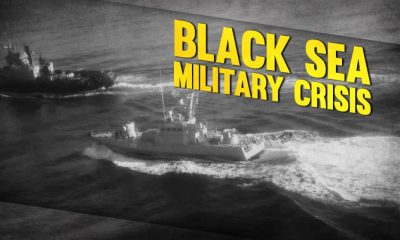U.S. Warships to Enter Black Sea in “Significant Signal” to Russia Over Ukraine

All Global Research articles can be read in 51 languages by activating the “Translate Website” drop down menu on the top banner of our home page (Desktop version).
***
Turkey has confirmed an earlier CNN report that the U.S. will send warships to the Black Sea in what a Pentagon official cited by CNN said was a demonstration of support to the government of Ukraine in response to claims of increased Russian military presence on Ukraine’s eastern border. The Black Sea is nowhere near the current conflict zone in the Donbass, further east of which the alleged Russian build-up is occurring.
Under terms of the 1936 Montreux Convention naval vessels from non-littoral nations have to notify Turkey, whose territory the Dardanelles and Bosporus Straits linking the Black Sea to the Mediterranean are, of a planned visit to the Black Sea nine days in advance. The ships, which will enter the sea on April 14 and 15 and stay until May 4 and 5, are the Arleigh Burke-class guided-missile destroyers USS Donald Cook and USS Roosevelt. The Convention regulates by tonnage individual ships and groups of ships entering the sea. More than two U.S. destroyers might surpass the limit of the latter maximum.
What advanced warships like the Tomahawk- and Standard Missile-3-equipped American destroyers are doing in a sea half a world away from the U.S. seems to be a question no one ever asks.
Russian news reports of the past twenty-four hours have quoted from the CNN feature the words of the unnamed Defense Department official that the deployment would “sent a significant signal” to Moscow. Delivering a message sounds innocuous enough. The traditional term for such an action is brinkmanship.
The CNN feature mentioned that U.S. Navy routinely operates in the Black Sea, crisis or no crisis, but that dispatching additional warships to the sea would “send a specific message to Moscow that the US is closely watching.” The equivalent of what’s being considered would be Russia sending several guided-missile cruisers through the St. Lawrence Seaway to the Great Lakes to “send a message” to the U.S. over Washington moving troops in the direction of the Canadian border.
The same Defense Department official informed CNN that U.S. Navy was flying reconnaissance flights over the Black Sea where Russia maintains its naval fleet of that name at Sevastopol in Crimea.
To increase U.S. and allied NATO military presence in the Black Sea region would mean a substantial forward presence indeed, as the U.S. had three guided-missile destroyers and a guided-missile cruiser in the Black Sea in the last three months, frequently two at a time: USS Thomas Hudner, USS Porter, USS Donald Cook and USS Monterey. The first three are destroyers, the last a cruiser. The destroyers can carry 56 Tomahawk missiles apiece, and both the destroyers and cruisers are part of the Navy’s Aegis Combat System and can also be equipped with Standard Missile-3 anti-ballistic missiles that could shoot down Russian missiles.
CNN also reported that on April 7 two American B-1 supersonic bombers (previously nuclear-capable) flew over the Aegean Sea, which gives access to the Black Sea.
The USS Dwight D. Eisenhower aircraft carrier with its attached carrier strike group is currently in the Eastern Mediterranean. Four guided-missile destroyers and a guided-missile cruiser are assigned to the group. The warships could have as many as 280 Tomahawk cruise missiles. Dwight D. Eisenhower has 90 fixed-wing planes and helicopters in addition to Sea Sparrow anti-aircraft and anti-missile missiles and Rolling Airframe Missile surface-to-air missiles. All within immediate striking range of the Black Sea.
The above comes against the backdrop of mounting anti-Russian rhetoric from Washington, with White House Press Secretary Jen Psaki stating on April 8:
“The United States is increasingly concerned by recently escalating Russian aggressions [sic] in eastern Ukraine, including Russia’s movements on Ukraine’s border. Russia now has more troops on the border of Ukraine than any time since 2014. Five Ukrainian soldiers have been killed this week alone. These are all deeply concerning signs.”
In recent days President Biden, Defense Secretary Lloyd Austin, Chairman of the Joint Chiefs Mark Milley, Secretary of State Anthony Blinken and National Security Advisor Jake Sullivan have all had conversations with Ukrainian counterparts on the intensified fighting in the Donbass and in regard to reported Russian “aggressions.”
Also on April 8 Interfax reported the Russian Defense Ministry announced it was relocating ten navy vessels, described as landing craft and artillery warships, from the Caspian Sea to the Black Sea for exercises. (As the Caspian is landlocked, the vessels can’t be of great size as they would be required to be moved overland.)
Without doubt we are witnessing the most serious escalation of tensions between the world’s two major nuclear powers since the first Soviet troops crossed the Oxus River to enter Afghanistan in late 1979. In fact maybe since the Cuban Missile Crisis.
*
Note to readers: please click the share buttons above or below. Forward this article to your email lists. Crosspost on your blog site, internet forums. etc.
Featured image is from South Front

